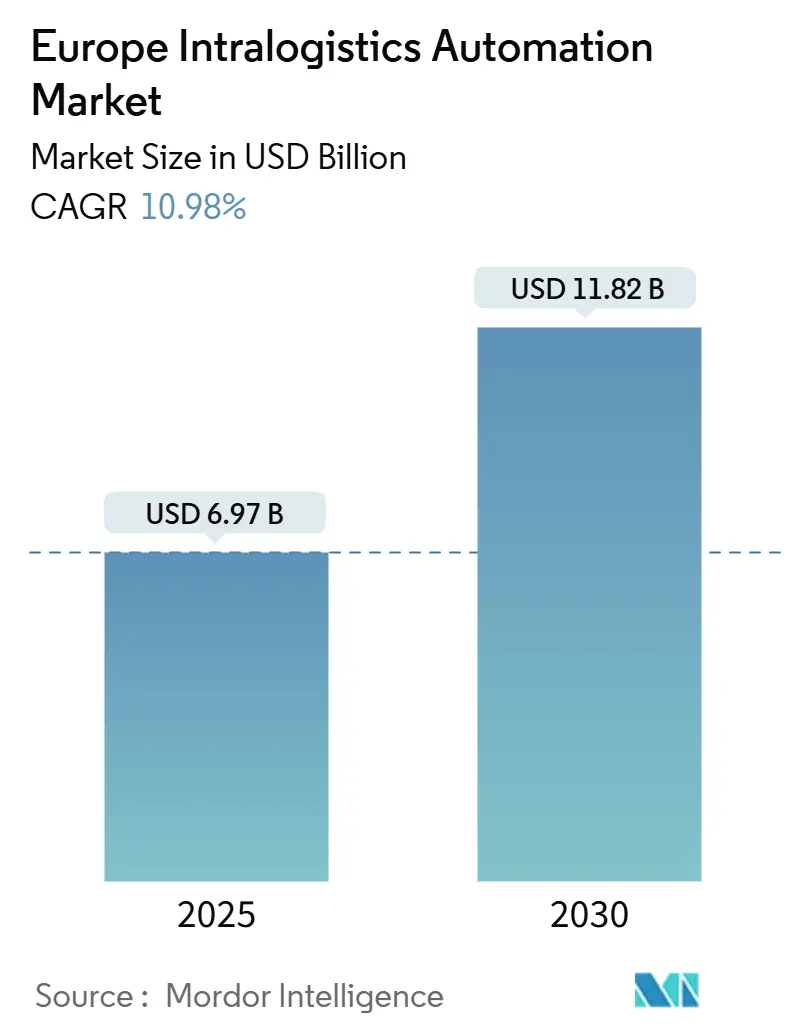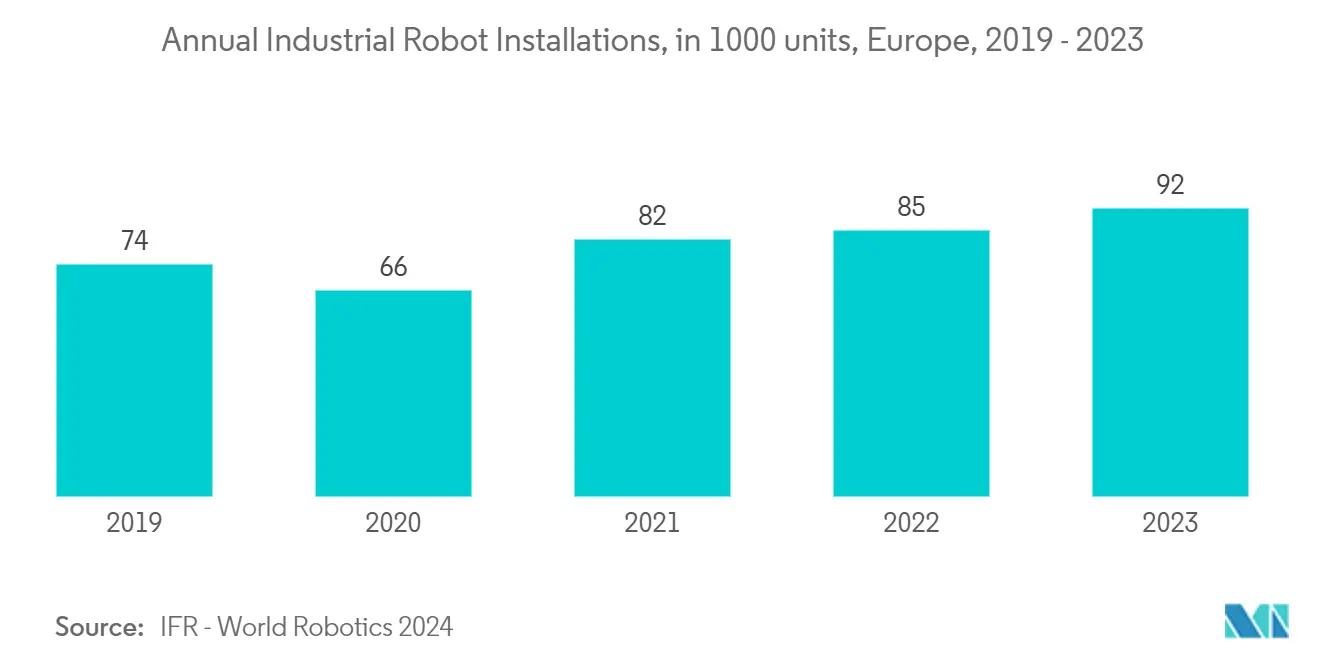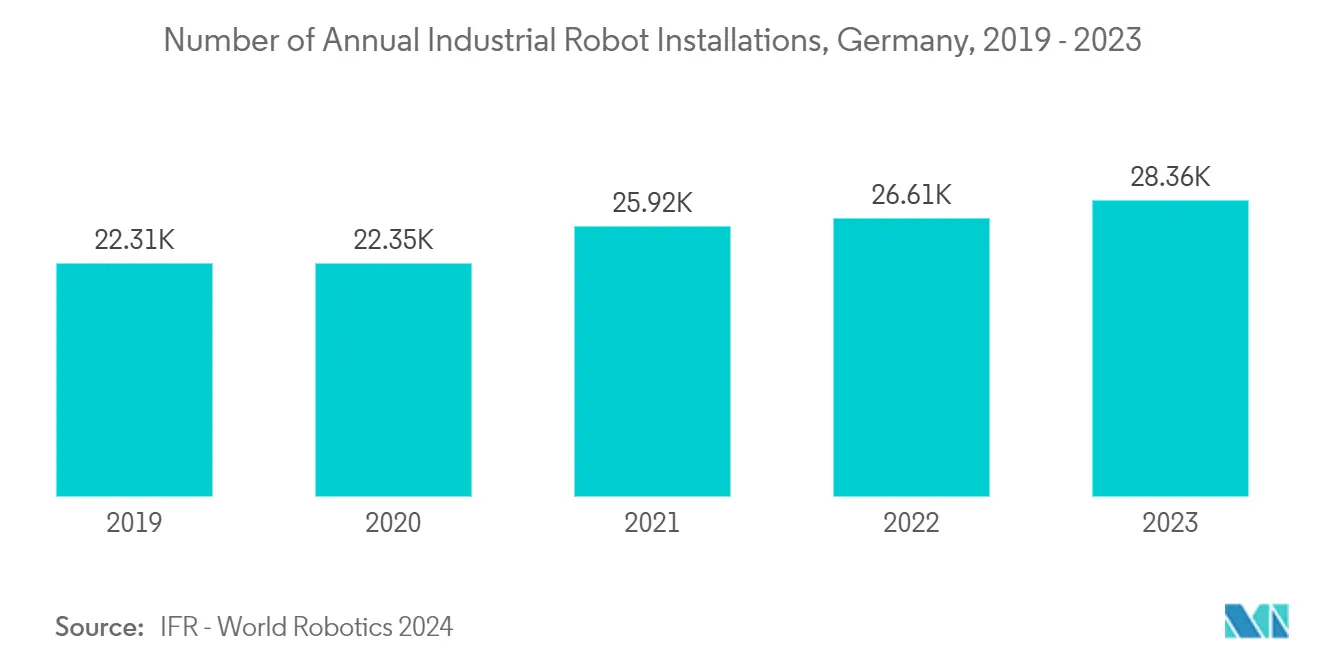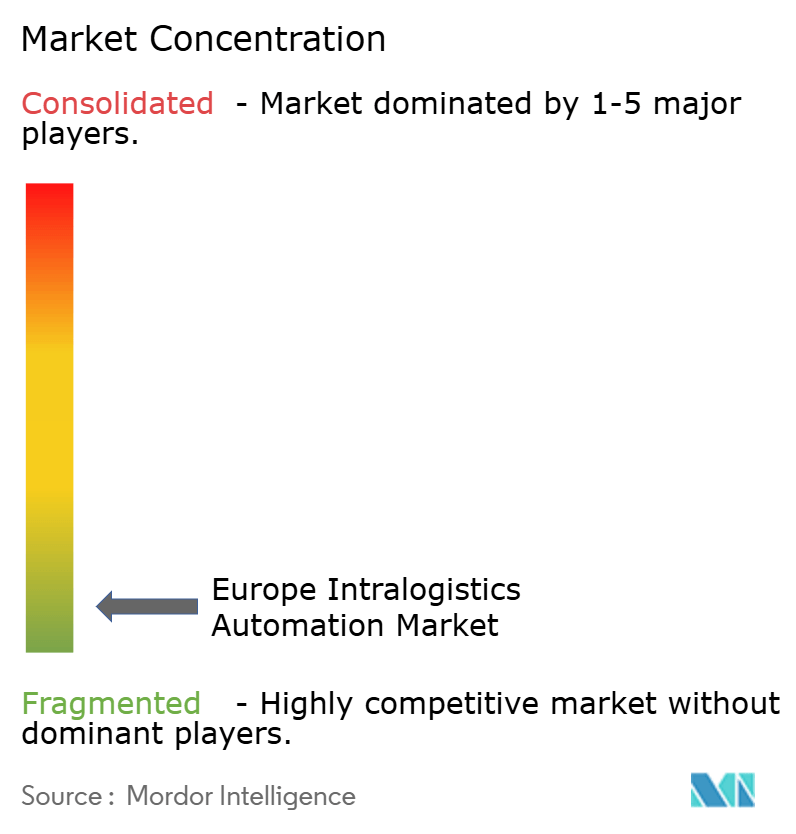Europe Intralogistics Automation Market Analysis
The Europe Intralogistics Automation Market size is estimated at USD 6.97 billion in 2025, and is expected to reach USD 11.82 billion by 2030, at a CAGR of 10.98% during the forecast period (2025-2030).
- Automated systems operate continuously, minimizing downtime and speeding up order fulfillment. This boosts productivity, enabling companies to manage larger volumes with the same or fewer resources. By streamlining operations, businesses can achieve faster turnaround times, which is critical in meeting customer expectations in competitive markets.
- Automation brings notable cost savings. By reducing labor costs and minimizing errors from manual handling, companies can also cut waste through better inventory management. Enhanced accuracy in picking and packing boosts customer satisfaction and leads to fewer returns and improved service levels. Additionally, automation reduces the need for overtime and other labor-related expenses, further optimizing operational budgets.
- Intralogistics automation bolsters safety by lessening the chances of workplace accidents tied to manual material handling. With robots and automated guided vehicles (AGVs) in play, the risk of injury diminishes, creating a safer workspace. This protects employees and reduces costs associated with workplace injuries, such as medical expenses and downtime.
- Intralogistics automation boosts productivity, accelerates order responses, and enhances storage density for organizations. Yet, many grapple with securing the necessary capital for these advancements. A significant part of this challenge stems from organizations not fully accounting for the hidden costs of sticking to their current systems. For example, beyond just the purchase price of an intralogistics system, organizations must also factor in ongoing expenses like spare parts, energy consumption, personnel costs, and maintenance.
- European countries, responding to the shifting geopolitical landscape—especially due to the Russia-Ukraine war and the US-China trade dispute—are intensifying efforts to bolster their local industrial ecosystems. This renewed focus is set to channel significant investments into industrial facilities, as well as retail, warehousing, and distribution sectors. These investments aim to enhance operational efficiency, reduce dependency on external supply chains, and strengthen regional resilience, thereby heralding a bright future for the intralogistics automation industry in Europe.
Europe Intralogistics Automation Market Trends
Automotive Holds Major Share
- Robotics is taking center stage in the automotive industry. The automotive sector has emerged as the leading adopter of industrial robots. The "World Robotics 2024" report from the International Federation of Robotics highlights that Germany installed 28,335 new industrial robots. This uptick is particularly striking given the downturn in robot installations across the globe's top four nations: China, Japan, the U.S., and South Korea. With a total of 269,427 installed units, Germany stands as Europe's top robotics user and ranks fifth worldwide. A notable 29% surge in the automotive sector fueled this growth in Germany.
- Key drivers of this trend include a shift towards electric vehicles and prevailing labor shortages. Automotive manufacturers are leveraging robots to enhance productivity, reduce costs, improve quality, and protect their workforce. The advent of collaborative robotics, or cobots, offers manufacturers innovative solutions, including the ability to position robots in close proximity to human workers without the need for safety barriers.
- Robotic process automation (RPA) is shifting the focus from physical robots to digital bots, enabling bots to address consumer inquiries. In the automotive sector, warehouses are increasingly automated, boosting efficiency and precision while slashing labor costs. This automation journey starts when goods arrive at the warehouse and concludes with their departure. Robots now handle everything from palletizing to picking, taking on repetitive and demanding tasks.
- In palletizing tasks, traditional systems employ articulated arms, utilizing robots that range from two-axis to seven-axis. These robots not only spare team members from the strain of lifting heavy loads but also maneuver full-stack pallets with greater efficiency than human workers. Equipped with a gripper attachment, these robots can effortlessly relocate boxes from one location to another.
- Emerging use cases are expanding to include piece picking, inducting (both ASRS and sorter), sorting, and decanting. A prime example of this transformation is the adoption of Automated Storage and Retrieval Systems (ASRS) in the automotive industry.
- ASRS is set to redefine the automotive landscape, streamlining operations, enhancing inventory oversight, bolstering safety measures, optimizing spatial use, and driving down costs. As the automotive realm increasingly leans into automation, ASRS emerges as a pivotal force, propelling the industry towards heightened efficiency, productivity, and competitive edge, all through the integration of robotics, sophisticated software, and data analytics.
Germany Expected to Hold Significant Market Share
- Germany's intralogistics automation market is booming, fueled by tech innovations, changing consumer habits, and a heightened demand for supply chain efficiency.
- Advanced technologies like artificial intelligence (AI), machine learning, and the Internet of Things (IoT) are transforming intralogistics. German firms are pouring investments into smart automation, harnessing tools for predictive analytics, real-time inventory oversight, and boosted operational transparency.
- As automation and robotics gain traction in the region, market growth is set to accelerate. Data from VDMA highlights that in 2023, Germany's robotics and automation sectors raked in EUR 16.2 billion (USD 16.83 billion). Forecasts suggest a rise to EUR 16.8 billion (USD 17.45 billion) in 2024. With automation's growing foothold, the region's industrial scene brims with market potential.
- Germany is poised for a surge in demand for intralogistics automation systems, driven by advancements in technology and the growing need for efficiency in logistics operations. In 2023, sales of robots for transport and logistics tasks reached nearly 113,000 units, marking a 35% increase compared to the previous year. These figures, published by the VDMA Materials Handling and Intralogistics Association in collaboration with the International Federation of Robotics (IFR), highlight the rapid adoption of automation in the sector. The automated storage and retrieval segment led Germany's intralogistics automation market in 2023, supported by increasing investments and the integration of innovative solutions to streamline supply chain processes.
Europe Intralogistics Automation Industry Overview
The European Intralogistics Automation market is fragmented and highly competitive. Product launches, high expenditure on research and development, partnerships and acquisitions, etc., are the prime growth strategies adopted by the companies in the region to sustain the intense competition. Top intralogistics companies use sustainable technologies and optimization systems for various end users. Major manufacturers are concentrating on creating and updating new software and service designs to solve issues with material arrangement and storage.
In the intralogistics automation market, both international and domestic players are in a fierce contest. The competitive rivalry is heightened by the presence of major companies like Daifuku Co. Limited, Honeywell Intelligrated, Interroll Holding, Jungheinrich, KION Group, and Murata Machinery, among others. These companies are investing heavily in research and development, expanding their product portfolios, and adopting aggressive marketing strategies to strengthen their market positions.
Technological disruption plays a pivotal role in establishing a sustainable competitive edge. Key players are consistently integrating new features and technologies into their products. For example, in March 2024, Loadhog, a leading packaging manufacturer, unveiled the Autotote 64. This container, tailored for intralogistics automation, boasts a patented design, ensuring smooth, quiet operation on automated systems without compromising strength and durability. Such innovations are aimed at addressing the evolving needs of end-users and enhancing operational efficiency.
Europe Intralogistics Automation Market Leaders
-
Viastore Systems GmbH
-
Vanderlande Industries B.V.
-
Daifuku Co. Ltd.
-
Honeywell Intelligrated
-
Interroll Group
- *Disclaimer: Major Players sorted in no particular order
Europe Intralogistics Automation Market News
- December 2024: Dematic expanded its footprint by opening a new office in Taiwan. This move not only cements Dematic's commitment to Taiwan but also highlights its focus on the broader North Asia region. The Taiwan office plays a crucial role in Dematic's overarching strategy: empowering Asian customers to achieve sustainable growth.
- October 2024: Vanderlande Industries BV has secured an agreement to purchase Siemens Logistics, a top-tier provider specializing in value-added baggage and cargo handling, alongside cutting-edge digital solutions tailored for the future of airport operations. This move sees Vanderlande acquiring Siemens Logistics directly from its current owner, Siemens. Notably, the acquisition boasts unanimous backing from the Supervisory and Management Boards of both Vanderlande and its parent entity, Toyota Industries Corporation (TICO), as well as Siemens' Management Board.
Europe Intralogistics Automation Industry Segmentation
Intralogistics integrates all internal business processes that take place while handling products. All industries are significantly impacted by the movement of goods during receipt, storage, and transfer, which is the subject of this phrase.
Intralogistics optimizes internal transport processes, boosting productivity and ensuring smooth operations. It supports manufacturing, installation, and operational startup of products and systems, forming a foundation for business success. Fulfillment and distribution centers require up-to-date, innovative intralogistics solutions. Effective intralogistics enhances supply chain visibility. Advanced monitoring systems provide real-time inventory data, enabling informed decisions on production and resource allocation. Data-driven decisions improve responsiveness to demand changes, increasing competitive edge, agility, and resilience.
Europe intralogistics automation market is segmented by product type (mobile robots, automated storage and retrieval systems,, automated sorting systems, palletizing and de-palletizing systems, automated conveyors, order picking systems), end-user industry (airport, post & parcel, general manufacturing, automotive, food and beverage, retail, warehousing & distribution, other end-user industries), country (United Kingdom, Germany, France, Italy, Spain, Rest of Europe). the market size and forecasts are provided in terms of value (USD) for all the above segments.
| Product Type | Mobile Robots | ||
| Automated Storage and Retrieval Systems | |||
| Automated Sorting Systems | |||
| Palletizing and De-palletizing Systems | |||
| Automated Conveyors | |||
| Order Picking Systems | |||
| End-user Industry | Airport | ||
| Post & Parcel | |||
| General Manufacturing | |||
| Automotive | |||
| Food and Beverage | |||
| Retail, Warehousing & Distribution | |||
| Other End-user Industries | |||
| Country | United Kingdom | Market Overview | |
| Product Analysis | |||
| Regional Market Dynamics | |||
| Germany | Market Overview | ||
| Product Analysis | |||
| Regional Market Dynamics | |||
| France | Market Overview | ||
| Product Analysis | |||
| Regional Market Dynamics | |||
| Italy | Market Overview | ||
| Product Analysis | |||
| Regional Market Dynamics | |||
| Spain | Market Overview | ||
| Product Analysis | |||
| Regional Market Dynamics | |||
Europe Intralogistics Automation Market Research FAQs
How big is the Europe Intralogistics Automation Market?
The Europe Intralogistics Automation Market size is expected to reach USD 6.97 billion in 2025 and grow at a CAGR of 10.98% to reach USD 11.82 billion by 2030.
What is the current Europe Intralogistics Automation Market size?
In 2025, the Europe Intralogistics Automation Market size is expected to reach USD 6.97 billion.
Who are the key players in Europe Intralogistics Automation Market?
Viastore Systems GmbH, Vanderlande Industries B.V., Daifuku Co. Ltd., Honeywell Intelligrated and Interroll Group are the major companies operating in the Europe Intralogistics Automation Market.
What years does this Europe Intralogistics Automation Market cover, and what was the market size in 2024?
In 2024, the Europe Intralogistics Automation Market size was estimated at USD 6.20 billion. The report covers the Europe Intralogistics Automation Market historical market size for years: 2019, 2020, 2021, 2022, 2023 and 2024. The report also forecasts the Europe Intralogistics Automation Market size for years: 2025, 2026, 2027, 2028, 2029 and 2030.
Our Best Selling Reports
Europe Intralogistics Automation Industry Report
The Europe Intralogistics Automation Market is experiencing robust growth, driven by the increasing adoption of Industry 4.0 technologies and the expansion of the e-commerce sector. Intralogistics, essential for optimizing internal logistics within organizations such as factories and distribution centers, involves sophisticated systems for material handling, inventory control, and order fulfillment. Significant advancements in automation technologies, including the use of drones, AI, and robotics, are enhancing operational efficiency and productivity. Key market segments include hardware components like automated storage and retrieval systems and software solutions that streamline logistics operations. The presence of major intralogistics companies and the integration of smart technologies are propelling the market forward, making Europe a leading region in industrial automation adoption. Despite challenges such as high installation costs and the complexity of integrating new technologies, the market offers substantial opportunities for growth, particularly in sectors like manufacturing, retail, and healthcare. The introduction of environmentally sustainable practices and continuous innovation by intralogistics companies are expected to further drive the Europe Intralogistics Automation Market. For detailed statistics, market share, size, revenue growth rate, and a forecast outlook, access a free report PDF download from Mordor Intelligence™ Industry Reports.







